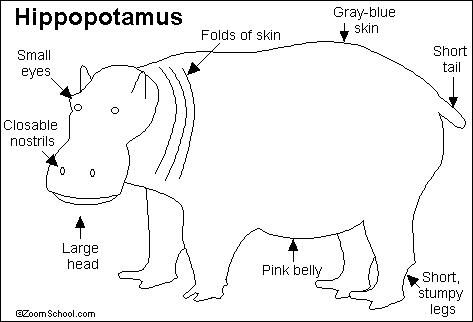
 |
| You might also like: | Hippo Read-and-Answer Quiz | Impala Printout | White Rhino Printout | Zebra Printout | Giraffe and baby Printout | Today's featured page: Golden Eagle Printout |
| Go to a Hippo Quiz All about Mammals | EnchantedLearning.com Hippopotamus | Animal Printouts Label Me! Printouts |


Diet and Behavior: Hippos are herbivores (plant-eaters). They are nocturnal (they are most active at night). Hippos spend the day resting and cooling off in shallow water, emerging from the water at night to graze on grass.
Hippos cans stay underwater for up to 5 to 6 minutes. Bulls (adult males) often roar; they also fight each other, using their enormous canine teeth as weapons. Females (called cows) give birth in the water. Baby hippos are called calves. Hippos have a life span of 40 years.
Anatomy: The Hippopotamus is about 4.5 feet (1.4 m) high at the shoulder and about 13 feet (4 m). It has a short tail, small eyes, a huge mouth and canine teeth up that are to 28 inches (72 cm) long. The enormous mouth can open 4 feet (1.2 m) wide. The legs are short and thick and the body is barrel-shaped. Despite its stubby shape, this aggressive animal is a very fast runner (faster than a human). Hippos weigh up to 10,000 pounds (4500 kg); they are the third-heaviest land animal (after the elephant and the white rhino). Baby hippos weigh 60-110 pounds (28-50 kg) at birth. Hippos have unusual pores on their almost-hairless body which exude a thick, oily, pink sweat.
Hippo populations are in decline because of hunting.
| Search the Enchanted Learning website for: |